Kohn Anomaly and Phase Stability in Group VB Transition Metals
Abstract
:1. Introduction
2. FS Nesting and Kohn Anomaly in V, Nb, and Ta
2.1. Early Search for Phase Transformations in V, Nb, and Ta
2.2. Fermi Surface Nesting and Pre-Martensitic Softening in V, Nb, and Ta at High Pressures
2.3. Strength and Elasticity of Nb and Ta
3. Discussion
Acknowledgments
Author Contributions
Conflicts of Interest
References
- Kohn, W. Image of the Fermi surface in the vibration spectrum of a metal. Phys. Rev. Lett. 1959, 2, 393–394. [Google Scholar] [CrossRef]
- Woll, E.J.; Kohn, W. Images of the Fermi Surface in phonon spectra in metals. Phys. Rev. 1962, 126, 1693–1697. [Google Scholar] [CrossRef]
- Peierls, R.E. Quantum Theory of Solids; Oxford University: New York, NY, USA, 1955. [Google Scholar]
- Bulaevskii, L.N. Structural and superconducting properties of system with one-dimensional anisotropy. In High-Temperature Superconductivity; Ginzburg, V.L., Kirzhnits, D.A., Eds.; Consultants Bureau: New York, NY, USA; London, UK, 1982; pp. 241–281. [Google Scholar]
- Zhu, X.; Guo, J.; Zhang, J.; Plummer, E.W. Misconceptions associated with the origin of charge density waves. Adv. Phys. X 2017, 2, 622–640. [Google Scholar] [CrossRef]
- Taylor, P.L. Theory of Kohn anomalies in the phonon spectra of metals. Phys. Rev. 1963, 131, 1995–1999. [Google Scholar] [CrossRef]
- Afanas’ev, A.M.; Kagan, Y. Singularities caused by electron-phonon interaction in the phonon dispersion law. Sov. J. Exp. Theor. Phys. 1963, 16, 1030–1034. [Google Scholar]
- Katsnelson, M.I.; Naumov, I.I.; Trefilov, A.V. Singularities of the electronic anomalies of lattice properties in structure and pre-martensitic β-phases of metals and alloys. Phase Trans. 1994, 49, 143–191. [Google Scholar] [CrossRef]
- Kopaev, Y.V. Possibility of an increase in the critical temperature as a result of a structural-transition-induced change in the electron spectrum. In High-Temperature Superconductivity; Ginzburg, V.L., Kirzhnits, D.A., Eds.; Consultants Bureau: New York, NY, USA; London, UK, 1982; pp. 179–211. [Google Scholar]
- Johannes, M.D.; Mazin, I.I.; Howells, C.A. Fermi-surface nesting and the origin of the charge-density wave in NbSe2. Phys. Rev. B 2006, 73, 205102. [Google Scholar] [CrossRef]
- Johannes, M.D.; Mazin, I.I. Fermi surface nesting and the origin of charge density waves in metals. Phys. Rev. B 2008, 77, 165135. [Google Scholar] [CrossRef]
- Keldysh, L.V.; Kopaev, Y. Possible instability of semimetallic state toward Coulomb interaction. Sov. Phys. Solid State 1965, 6, 2219–2224. [Google Scholar]
- Halperin, B.I.; Rice, T.M. Possible anomalies at a semimetal-semiconductor transition. Rev. Mod. Phys. 1968, 40, 755–766. [Google Scholar] [CrossRef]
- Barzykin, V.V.; Gor’kov, L.P. Ferromagnetism and superstructure in Ca1−xLaxB6. Phys. Rev. Lett. 2000, 84, 2207–2210. [Google Scholar] [CrossRef] [PubMed]
- Faraggi, M.N.; Zubizarreta, X.; Arnau, A.; Silkin, V.M. On the stability of the electronic system in transition metal dichalcogenides. J. Phys. Condens. Matter 2016, 28, 184004. [Google Scholar] [CrossRef] [PubMed]
- Gor’kov, L.P. Strong electron-lattice coupling as the mechanism behind charge density wave transformations in transition-metal dichalcogenides. Phys. Rev. B 2012, 85, 165142. [Google Scholar] [CrossRef]
- Lander, G.H.; Fisher, E.S.; Bader, S.D. The solid-state properties of uranium a historical perspective and review. Adv. Phys. 1994, 43, 1–111. [Google Scholar] [CrossRef]
- Marmeggi, J.C.; Currat, R.; Bouvet, A.; Lander, G.H. Phonon softening in alpha-uranium associated with the CDW transition. Phys. B Condens. Matter 1999, 263–264, 624–626. [Google Scholar] [CrossRef]
- Fast, L.; Eriksson, O.; Johansson, B.; Wills, J.M.; Straub, G.; Roeder, H.; Nordström, L. Theoretical aspects of the charge density waves in uranium. Phys. Rev. Lett. 1998, 81, 2978–2981. [Google Scholar] [CrossRef]
- Chan, S.-K.; Heine, V. Spin density wave and soft phonon mode from nesting Fermi surfaces. J. Phys. F Met. Phys. 1973, 3, 795–809. [Google Scholar] [CrossRef]
- Zhao, G.-L.; Leung, T.C.; Harmon, B.N.; Keil, M.; Müllner, M.; Weber, W. Electronic origin of the intermediate phase of NiTi. Phys. Rev. B 1989, 40, 7999–8001. [Google Scholar] [CrossRef]
- Naumov, I.I.; Velikokhatnyi, O.I.; Bashirov, V.Z. Charge density waves in B2 titanium compounds. JETP Lett. 1991, 54, 573–577. [Google Scholar]
- Velikokhatnyi, O.I.; Naumov, I.I. Electronic structure and instability of Ni2MnGa. Phys. Solid State 1999, 41, 617–623. [Google Scholar] [CrossRef]
- Lee, Y.; Rhee, J.Y.; Harmon, B.N. Generalized susceptibility of the magnetic shape-memory alloy Ni2MnGa. Phys. Rev. B 2002, 66, 54424. [Google Scholar] [CrossRef]
- Bungaro, C.; Rabe, K.M.; Dal Gorso, A. First-principles study of lattice instabilities in ferromagnetic Ni2MnGa. Phys. Rev. B 2003, 68, 134104. [Google Scholar] [CrossRef]
- Zayak, A.T.; Entel, P.A. Critical discussion of calculated modulated structures, Fermi surface nesting and phonon softening in magnetic shape memory alloys Ni2Mn(Ga, Ge, Al) and Co2Mn(Ga, Ge). J. Magn. Magn. Mater. 2005, 290–291, 874–877. [Google Scholar] [CrossRef]
- Haynes, T.D.; Watts, R.J.; Laverock, J.; Major, Z.; Alam, M.A.; Taylor, J.W.; Duffy, J.A.; Dugdale, S.B. Positron annihilation study of the Fermi surface of Ni2MnGa. New J. Phys. 2012, 14, 035020. [Google Scholar] [CrossRef]
- Zhao, G.L.; Harmon, B.N. Phonon anomalies in β-phase NixAl1−x alloys. Phys. Rev. B 1992, 45, 2818. [Google Scholar] [CrossRef]
- Naumov, I.I.; Velikokhatnyi, O.I. Simultaneous manifestations of the 2D van Hove singularity and the Fermi surface nesting in the acoustic soft mode of β-NiAl alloys. J. Phys. Condens. Matter 1997, 9, 10339–10351. [Google Scholar] [CrossRef]
- Huang, X.; Naumov, I.I.; Rabe, K.M. Phonon anomalies and elastic constants of cubic NiAl from first principles. Phys. Rev. B 2004, 70, 064301. [Google Scholar] [CrossRef]
- Kakeshita, T.; Fukuda, T.; Saburi, T. Time-dependent nature and origin of displacive transformation. Sci. Technol. Adv. Mater. 2000, 1, 63–72. [Google Scholar] [CrossRef]
- Velikokhatnyi, O.I.; Naumov, I.I.; Bashirov, V.Z. Geometric features of the Fermi surface and the premartensitic anomalies in the Hume-Rothery β-Phases. Phys. Met. Metallogr. 1992, 74, 557–564. [Google Scholar]
- Velikokhatnyi, O.I.; Eremeev, S.V.; Naumov, I.I.; Potekaev, A.I. Long-period incommensurate superstructures in Cu–Au alloys: Relation with short-period ordering. J. Exp. Theor. Phys. 2000, 90, 479–487. [Google Scholar] [CrossRef]
- Velikokhatnyi, O.I.; Naumov, I.I.; Eremeev, S.V.; Potekaev, A.I. Two-dimensional incommensurate superlattices in precious-metals alloys: Nature of formation. JETP Lett. 1999, 69, 589–595. [Google Scholar] [CrossRef]
- Velikokhatnyi, O.I.; Eremeev, S.V.; Naumov, I.I.; Potekaev, A.I. Electronic structure and long period states in Ag3Mg: Comparison with Cu–Au alloys. J. Phys. Condens. Matter 2000, 12, 8825–8830. [Google Scholar] [CrossRef]
- Velikokhatnyi, O.I.; Eremeev, S.V.; Naumov, I.I.; Potekaev, A.I. Al3Ti alloy: Long-period states and electronic structure. J. Phys. Condens. Matter 2002, 14, 8763–8769. [Google Scholar] [CrossRef]
- Naumov, I.I.; Cohen, R.E.; Hemley, R.J. Graphene physics and insulator-metal transition in compressed hydrogen. Phys. Rev. B 2013, 88, 045125. [Google Scholar] [CrossRef]
- Politano, A.; Marino, A.R.; Formoso, V.; Chiarello, G. Evidence of Kohn anomalies in quasi-freestanding graphene on Pt(111). Carbon 2012, 50, 734–736. [Google Scholar] [CrossRef]
- Politano, A.; de Juan, F.; Chiarello, G.; Fertig, H.A. Emergence of an out-of-plane optical phonon (ZO) Kohn anomaly in quasifreestanding epitaxial graphene. Phys. Rev. Lett. 2015, 115, 075504. [Google Scholar] [CrossRef] [PubMed]
- Struzhkin, V.V.; Timofeev, Y.A.; Hemley, R.J.; Mao, H.-K. Superconducting Tc and electron-phonon coupling in Nb to 132 GPa: Magnetic susceptibility at megabar pressures. Phys. Rev. Lett. 1997, 79, 4262–4965. [Google Scholar] [CrossRef]
- Söderlind, P.; Moriarty, J.A. First-principles theory of Ta up to 10 Mbar pressure: Structural and mechanical properties. Phys. Rev. B 1998, 57, 10340. [Google Scholar] [CrossRef]
- Weir, S.T.; Akella, J.; Ruddle, C.; Goodwin, T.; Hsiung, L. Static strengths of Ta and U under ultrahigh pressures. Phys. Rev. B 1998, 58, 11258. [Google Scholar] [CrossRef]
- Cynn, H.; Yoo, C.-S. Equation of state of tantalum to 174 GPa. Phys. Rev. B 1999, 59, 8526. [Google Scholar] [CrossRef]
- Takemura, K. Equation of state of V and Nb under truly hydrostatic conditions. In Proceedings of the International Conference on High Pressure Science and Technology (AIRAPT-17), Honolulu, HI, USA, 25–30 July 1999; Manghnani, M.H., Nellis, W.J., Nicol, M.F., Eds.; Universities Press: Hyderabad, India, 2000; pp. 443–444. [Google Scholar]
- Ostanin, S.A.; Trubitsin, V.Y.; Savrasov, S.Y.; Alouani, M.; Dreyssé, H. Calculated Nb superconducting transition temperature under hydrostatic pressure. Comput. Mater. Sci. 2000, 17, 202–205. [Google Scholar] [CrossRef]
- Ishizuka, M.; Iketani, M.; Endo, S. Pressure effect on superconductivity of vanadium at megabar pressures. Phys. Rev. B 2000, 61, R3823. [Google Scholar] [CrossRef]
- Yang, L.H.; Söderlind, P.; Moriarty, J.A. Atomistic simulation of pressure-dependent screw dislocation properties in bcc tantalum. Mater. Sci. Eng. A 2001, 309–310, 102–107. [Google Scholar] [CrossRef]
- Singh, A.K.; Takemura, K. Measurement and analysis of nonhydrostatic lattice strain component in niobium to 145 GPa under various fluid pressure-transmitting media. J. Appl. Phys. 2001, 90, 3269–3275. [Google Scholar] [CrossRef] [Green Version]
- Suzuki, N.; Otani, M. Theoretical study on the lattice dynamics and electron-phonon interaction of vanadium under high pressures. J. Phys. Condens. Matter 2002, 14, 10869–10872. [Google Scholar] [CrossRef]
- Gülseren, O.; Cohen, R.E. High-pressure thermoelasticity of body-centered-cubic tantalum. Phys. Rev. B 2002, 65, 064103. [Google Scholar] [CrossRef]
- Louis, C.N.; Iyakutti, K. Electron phase transition and superconductivity of vanadium under high pressures. Phys. Rev. B 2003, 67, 094509. [Google Scholar] [CrossRef]
- Nnolim, N.O.; Tyson, T.A.; Axe, L. Theory of the structural phases of group 5B–6B metals and their transport properties. J. Appl. Phys. 2003, 93, 4543–4560. [Google Scholar] [CrossRef]
- Tse, J.S.; Li, Z.; Uehara, K.; Ma, Y. Electron phonon coupling in high-pressure Nb. Phys. Rev. B 2004, 69, 132101. [Google Scholar] [CrossRef]
- Dewaele, A.; Loubeyre, P.; Mezouar, M. Refinement of the equation of state of tantalum. Phys. Rev. B 2004, 69, 092106. [Google Scholar] [CrossRef]
- Dewaele, A.; Loubeyre, P. Mechanical properties of tantalum under high pressure. Phys. Rev. B 2005, 72, 134106. [Google Scholar] [CrossRef]
- Klepeis, J.E.; Landa, A.; Söderlind, P. Electronic Topological Transitions in High-Pressure BCC Metals. In Proceedings of the 2005 APS March Meeting, Los Angeles, CA, USA, 21–25 March 2005; American Institute of Physics: College Park, MD, USA, 2005; Volume 50, p. 600. [Google Scholar]
- Takemura, K.; Singh, A.K. High-pressure equation of state for Nb with helium-pressure medium: Powder X-ray diffraction experiments. Phys. Rev. B 2006, 73, 224119. [Google Scholar] [CrossRef]
- Orlikowski, D.; Söderlind, P.; Moriarty, J.A. First-principles thermoelasticity of transition metals at high pressure: Tantalum prototype in the quasiharmonic limit. Phys. Rev. B 2006, 74, 054109. [Google Scholar] [CrossRef]
- Landa, A.; Klepeis, J.; Söderlind, P.; Naumov, I.; Velikokhatnyi, O.; Vitos, L.; Ruban, A. Fermi surface nesting and pre-martensitic softening in V and Nb at high pressures. J. Phys. Condens. Matter 2006, 18, 5079–5085. [Google Scholar] [CrossRef]
- Landa, A.; Klepeis, J.; Söderlind, P.; Naumov, I.; Velikokhatnyi, O.; Vitos, L.; Ruban, A. Ab initio calculations of elastic constants of the bcc V–Nb system at high pressures. J. Phys. Chem. Solids 2006, 67, 2056–2064. [Google Scholar] [CrossRef]
- Suzuki, N.; Otani, M. The role of the phonon anomaly in the superconductivity of vanadium and selenium under high pressures. J. Phys. Condens. Matter 2007, 19, 125206. [Google Scholar] [CrossRef]
- Ding, Y.; Ahuja, R.; Shu, J.; Chow, P.; Luo, W.; Mao, H.K. Structural phase transition of vanadium at 69 GPa. Phys. Rev. Lett. 2007, 98, 085502. [Google Scholar] [CrossRef] [PubMed]
- Luo, W.; Ahuja, R.; Ding, Y.; Mao, H.K. Unusual lattice dynamics of vanadium under high pressure. Proc. Natl. Acad. Sci. USA 2007, 104, 16428–16431. [Google Scholar] [CrossRef] [PubMed]
- Lee, B.; Rudd, R.E.; Klepeis, J.E.; Söderlind, P.; Landa, A. Theoretical confirmation of a high-pressure rhombohedral phase in vanadium metal. Phys. Rev. B 2007, 75, 180101. [Google Scholar] [CrossRef]
- Lee, B.; Rudd, R.E.; Klepeis, J.E.; Becker, R. Elastic constants and volume changes associated with two high-pressure rhombohedral phase transformations in vanadium. Phys. Rev. B 2008, 77, 134105. [Google Scholar] [CrossRef]
- Rudd, R.E.; Klepeis, J.E. Multiphase improved Steinberg-Guinan model for vanadium. J. Appl. Phys. 2008, 104, 093528. [Google Scholar] [CrossRef]
- Verma, A.K.; Modak, P. Structural phase transitions in vanadium under high pressure. Europhys. Lett. 2008, 81, 37003. [Google Scholar] [CrossRef]
- Qiu, S.L.; Marcus, P.M. Phases of vanadium under pressure investigated from first principles. J. Phys. Condens. Matter 2008, 20, 275218. [Google Scholar] [CrossRef] [PubMed]
- Koči, L.; Ma, Y.; Oganov, A.R.; Souvatzis, P.; Ahuja, R. Elasticity of the superconducting metals V, Nb, Ta, Mo, and W at high pressure. Phys. Rev. B 2008, 77, 214101. [Google Scholar] [CrossRef]
- Bosak, A.; Hoesch, M.; Antonangeli, D.; Farber, D.L.; Fischer, I.; Krisch, M. Lattice dynamics of vanadium: Inelastic X-ray scattering measurements. Phys. Rev. B 2008, 78, 020301. [Google Scholar] [CrossRef]
- Landa, A.; Söderlind, P.; Ruban, A.V.; Peil, A.V.; Vitos, L. Stability in BCC transition metals: Madelung and band-energy effects due to alloying. Phys. Rev. Lett. 2009, 103, 235501. [Google Scholar] [CrossRef] [PubMed]
- Vekilov, Y.K.; Krasil’nikov, O.M. Structural transformations in metals at high compression ratios. Phys. Usp. 2009, 52, 831–834. [Google Scholar] [CrossRef]
- Antonangeli, D.; Farber, D.L.; Said, A.H.; Benedetti, L.R.; Aracne, C.M.; Landa, A.; Söderlind, P.; Klepeis, J.E. Shear softening of tantalum at megabar pressures. Phys. Rev. B 2010, 82, 132101. [Google Scholar] [CrossRef]
- Bondarenko, N.G.; Vekilov, Y.K.; Isaev, E.I.; Krasil’nikov, O.M. Deformation Phase Transition in Vanadium under High Pressure. JETP Lett. 2010, 91, 611–613. [Google Scholar] [CrossRef]
- Klepeis, J.-H.P.; Cynn, H.; Evans, W.J.; Rudd, R.E.; Yang, L.H.; Liermann, H.P.; Yang, W. Diamond anvil cell measurement of high-pressure yield strength of vanadium using in situ thickness determination. Phys. Rev. B 2010, 81, 134107. [Google Scholar] [CrossRef]
- Landa, A.; Söderlind, P.; Velikokhatnyi, O.I.; Naumov, I.I.; Ruban, A.V.; Peil, O.E.; Vitos, L. Alloying-driven phase stability in group-VB transition metals under compression. Phys. Rev. B 2010, 82. [Google Scholar] [CrossRef]
- Jenei, Z.; Liermann, H.P.; Cynn, H.; Klepeis, J.-H.P.; Baer, B.J.; Evans, W.J. Structural phase transition in vanadium at high pressure and high temperature: Influence of nonhydrostatic conditions. Phys. Rev. B 2011, 83, 054101. [Google Scholar] [CrossRef]
- Krasil’nikov, O.M.; Vekilov, Y.K.; Isaev, E.I.; Bondarenko, N.G. Theory of elastic phase transitions in metals at high pressures. Application to vanadium. J. Exp. Theor. Phys. 2011, 112, 240–245. [Google Scholar] [CrossRef]
- Liu, Z.; Shang, J. First principles calculations of electronic properties and mechanical properties of bcc molybdenum and niobium. Rare Met. 2011, 30, 354–358. [Google Scholar] [CrossRef]
- Singh, A.K.; Liermann, H.-P. Strength and elasticity of niobium under high pressure. J. Appl. Phys. 2011, 109, 113539. [Google Scholar] [CrossRef]
- Liu, Z.-H.; Shang, J.-X. Elastic properties of Nb-based alloys by using the density functional theory. Chin. Phys. B 2012, 21, 016202. [Google Scholar] [CrossRef]
- Krasil’nikov, O.M.; Vekilov, Y.K.; Mosyagin, I.Y.; Isaev, E.I.; Bondarenko, N.G. Elastic phase transitions in metals at high pressures. J. Phys. Condens. Matter 2012, 24, 195402. [Google Scholar] [CrossRef] [PubMed]
- Hu, J.; Dai, C.; Yu, Y.; Liu, Z.; Tan, Y.; Zhou, X.; Tan, H.; Cai, L.; Wu, Q. Sound velocity measurements of tantalum under shock compression in the 10–110 GPa range. J. Appl. Phys. 2012, 111, 033511. [Google Scholar] [CrossRef]
- Guerrero, O.; Marucho, M. Elastic-Plastic transition under uniaxial stress BCC tantalum. J. Mater. Sci. Eng. B 2013, 3, 153–160. [Google Scholar]
- Yu, Y.; Tan, Y.; Dai, C.; Li, X.; Li, Y.; Wu, Q.; Tan, H. Phase transition and strength of vanadium under shock compression up to 88 GPa. Appl. Phys. Lett. 2014, 105, 201910. [Google Scholar] [CrossRef]
- Zhang, L.Q.; Cheng, Y.; Niu, Z.W. Elastic properties and phonon dispersion of bcc vanadium under pressure from first principles. J. At. Mol. Sci. 2014, 5, 81–94. [Google Scholar] [CrossRef]
- Krasil’nikov, O.M.; Vekilov, Y.K.; Lugovskoy, A.V.; Mosyagin, I.Y.; Belov, M.P.; Bondarenko, N.G. Structural transformations at high pressure in the refractory metals (Ta, Mo, V). J. Alloy. Compd. 2014, 586, S242–S245. [Google Scholar]
- Jing, Q.; Wu, Q.; Xu, J.-A.; Bi, Y.; Liu, L.; Liu, S.; Zhang, Y.; Geng, H. Anomalous softening of yield strength in tantalum at high pressures. J. Appl. Phys. 2015, 117, 055903. [Google Scholar] [CrossRef]
- Hamlin, J.J. Superconductivity in the metallic elements at high pressures. Phys. C 2015, 514, 59–76. [Google Scholar] [CrossRef]
- Wang, Y.X.; Wu, Q.; Xiang, R.; Chen, X.R.; Geng, H.Y. Stability of rhombohedral phases in vanadium at high-pressure and high-temperature: First-principles investigations. Sci. Rep. 2016, 6, 32419. [Google Scholar] [CrossRef] [PubMed]
- Antonangeli, D.; Farber, D.L.; Bosak, A.; Aracne, C.M.; Ruddle, D.G.; Krisch, M. Phonon triggered rhombohedral lattice distortion in vanadium at high pressure. Sci. Rep. 2016, 6, 31887. [Google Scholar] [CrossRef] [PubMed]
- Wang, Y.X.; Geng, H.Y.; Wu, Q.; Chen, X.R.; Sun, Y. First-principles investigation of elastic anomalies in niobium at high pressure and temperature. J. Appl. Phys. 2017, 122, 235903. [Google Scholar] [CrossRef]
- Landau, L.D.; Lifshitz, E.M. Statistical Physics; Pergamon Press: Oxford, UK, 1980; Volume 1. [Google Scholar]
- Nakagawa, Y.; Woods, A.D.B. Lattice Dynamics of Nb. Phys. Rev. Lett. 1963, 11, 271–274. [Google Scholar] [CrossRef]
- Woods, A.D.B. Lattice dynamics of tantalum. Phys. Rev. 1964, 136, A781–A783. [Google Scholar] [CrossRef]
- Bosak, A.; European Synchrotron Radiation Facility, Grenoble, France. Personal communication, 2010.
- Powell, B.M.; Martel, R.; Woods, A.D.B. Lattice Dynamics of Niobium-Molybdenum Alloys. Phys. Rev. 1968, 171, 727–736. [Google Scholar] [CrossRef]
- Powell, B.M.; Martel, R.; Woods, A.D.B. Phonon properties of niobium, molybdenum, and their alloys. Can. J. Phys. 1977, 55, 1601–1612. [Google Scholar] [CrossRef]
- Ahuja, R.; Söderlind, P.; Trygg, J.; Melsen, J.; Wills, J.M.; Johansson, B.; Eriksson, O. Influence of pseudocore valence-band hybridization on the crystal-structure phase stabilities of transition metals under extreme compressions. Phys. Rev. B 1994, 50, 14690. [Google Scholar] [CrossRef]
- Steinberg, D.J.; Cochran, S.G.; Guinan, M.W. A constitutive model for metals applicable at high-strain rate. J. Appl. Phys. 1980, 51, 1498–1504. [Google Scholar] [CrossRef]
- Fridel, J. Electronic structure of primary solid solutions in metals. Adv. Phys. 1954, 3, 446–507. [Google Scholar] [CrossRef]
- Pettifor, D.G. Theory of the crystal structures of transition metals. J. Phys. C 1970, 3, 367–377. [Google Scholar] [CrossRef]
- Skriver, H.L. Crystal structure from one-electron theory. Phys. Rev. B 1985, 31, 1909–1923. [Google Scholar] [CrossRef]
- Söderlind, P.; Ahuja, R.; Erikson, O.; Wills, J.M.; Johansson, B. Crystal structure and elastic-constant anomalies in the magnetic 3d transition metals. Phys. Rev. B 1994, 50, 5918. [Google Scholar] [CrossRef]
- Clatterbuck, D.; Krenn, C.; Cohen, M.; Morris, J. Phonon instabilities and the ideal strength of aluminum. Phys. Rev. Lett. 2003, 91, 135501. [Google Scholar] [CrossRef] [PubMed]
- Li, J.; Zhu, T.; Yip, S.; Van Vliet, K.J.; Suresh, S. Elastic criterion for dislocation nucleation. Mater. Sci. Eng. A 2004, 365, 25–30. [Google Scholar] [CrossRef]
- Landa, A.; Söderlind, P.; Yang, L.H. Ab initio phase stability at high temperatures and pressures in the V–Cr system. Phys. Rev. B 2014, 89, 020101. [Google Scholar] [CrossRef]
- Dai, C.; Jin, X.; Zhou, X.; Liu, J.; Hu, J. Sound velocity variations and melting of vanadium under shock compression. J. Phys. Appl. Phys. 2001, 34, 3064–3070. [Google Scholar] [CrossRef]
- Errandonea, D.; Schwager, B.; Ditz, R.; Gessmann, C.; Boehler, R.; Ross, M. Systematics of transition-metal melting. Phys. Rev. B 2001, 63, 132104. [Google Scholar] [CrossRef]
- Okamoto, H. N-V (Nitrogen-Vanadium). J. Phase Equilibria 2001, 22, 362–364. [Google Scholar] [CrossRef]
- Kubel, F.; Lengauer, W.; Yvon, K.; Knorr, K.; Junod, A. Structural phase transition at 205 K in stoichiometric vanadium nitride. Phys. Rev. B 1988, 38, 12908–12912. [Google Scholar] [CrossRef]
- Wolf, W.; Podloucky, R.; Antretter, T.; Fisher, F.D. First-principles study of elastic and thermal properties of refractory carbides and nitrides. Philos. Mag. B 1999, 79, 839–858. [Google Scholar] [CrossRef]
- Isaev, E.I.; Simak, S.I.; Abrikosov, I.A.; Ahuja, R.; Vekilov, Y.K.; Katsnelson, M.I.; Lichtenstein, A.I.; Johansson, B. Phonon related properties of transition metals, their carbides, and nitrides: A first-principles study. J. Appl. Phys. 2007, 101, 123519. [Google Scholar] [CrossRef]
- Ivashchenko, V.I.; Turchi, P.E.A. Phonon softening and the phase transition in VN. Phys. Rev. B 2008, 78, 224113. [Google Scholar] [CrossRef]
- Řehák, P.; Černý, M.; Holec, D. Interface-induced electronic structure toughening of nitride superlattices. Surf. Coat. Technol. 2017, 325, 410–416. [Google Scholar] [CrossRef]
- Mei, A.B.; Hellman, O.; Wireklint, N.; Schlepütz, C.M.; Sangiovanni, D.G.; Alling, B.; Rockett, A.; Hultman, L.; Petrov, I.; Greene, J.E. Dynamic and structural stability of cubic vanadium nitride. Phys. Rev. B 2015, 91, 054101. [Google Scholar] [CrossRef]
- Kubel, F.; Flack, H.D.; Yvon, K. Electron densities in VN. I. High-precission X-ray diffraction determination of the valence-electron density distribution and atomic displacement parameters. Phys. Rev. B 1987, 36, 1415. [Google Scholar] [CrossRef]
- Zheng, Q.; Mei, A.B.; Tuteja, M.; Sangiovanni, D.G.; Hultman, L.; Petrov, I.; Greene, J.E.; Cahill, D.G. Phonon and electron contributions to the thermal conductivity of VNx epitaxial layers. Phys. Rev. Mater. 2017, 1, 065002. [Google Scholar] [CrossRef]
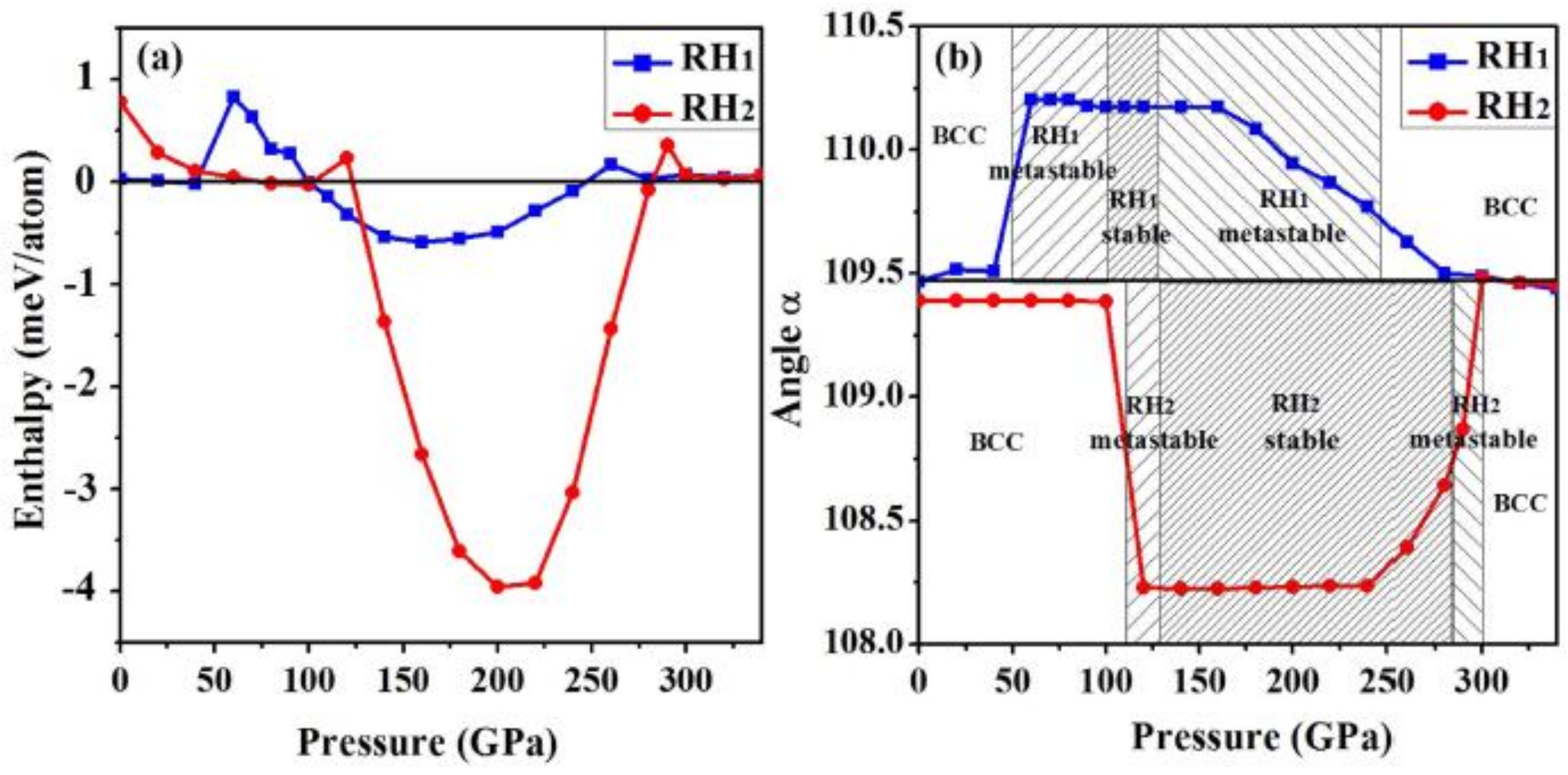

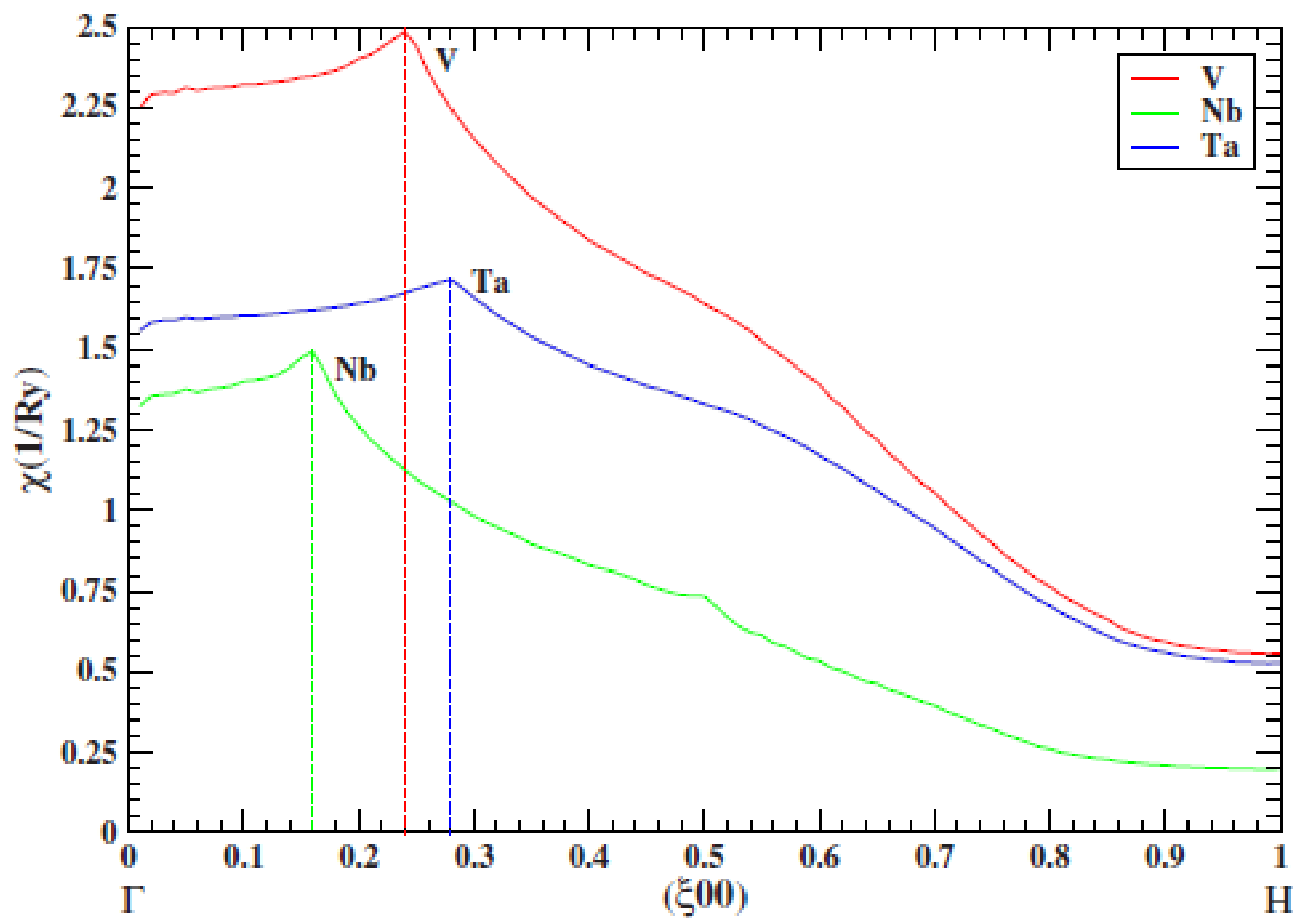
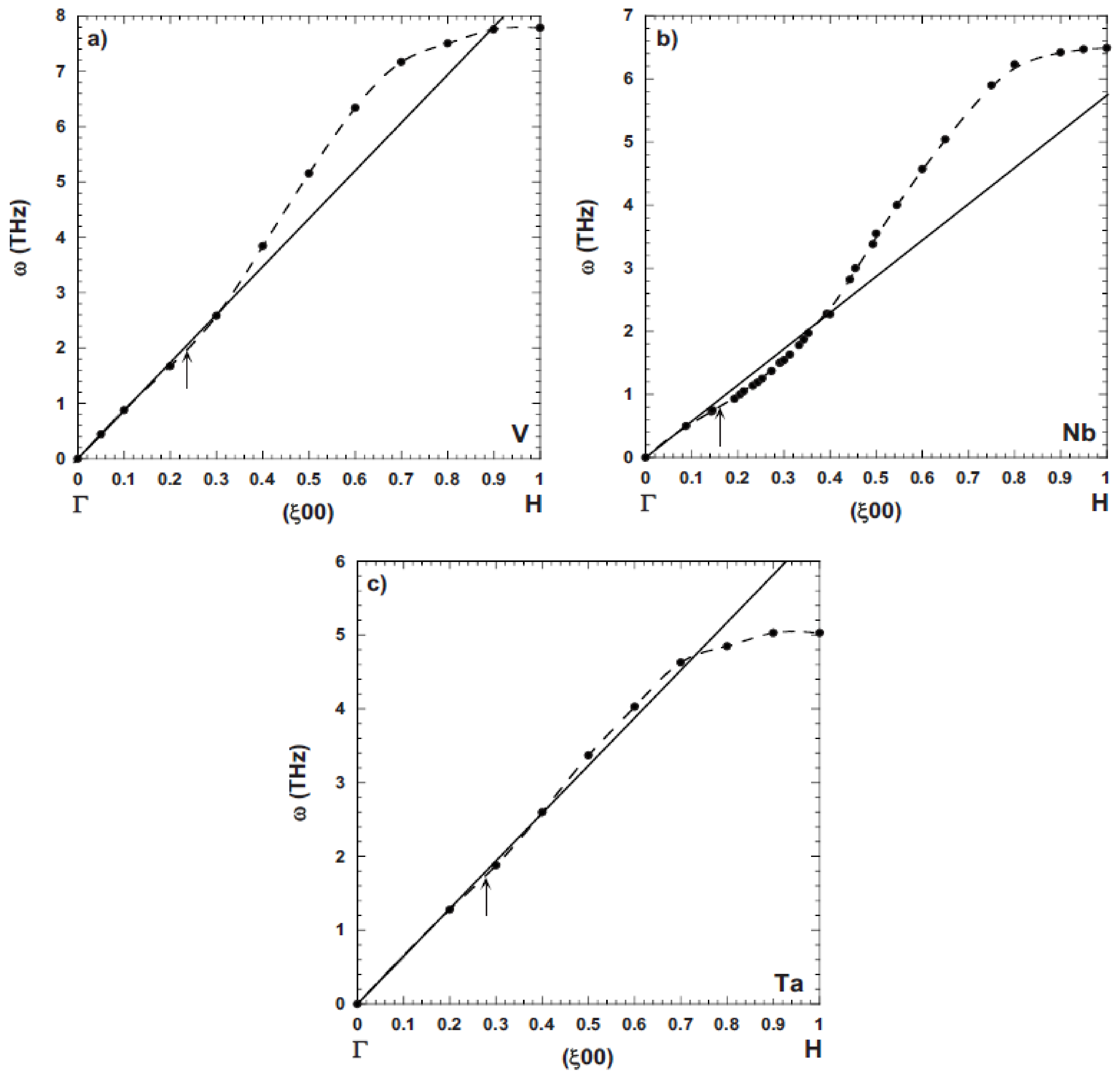
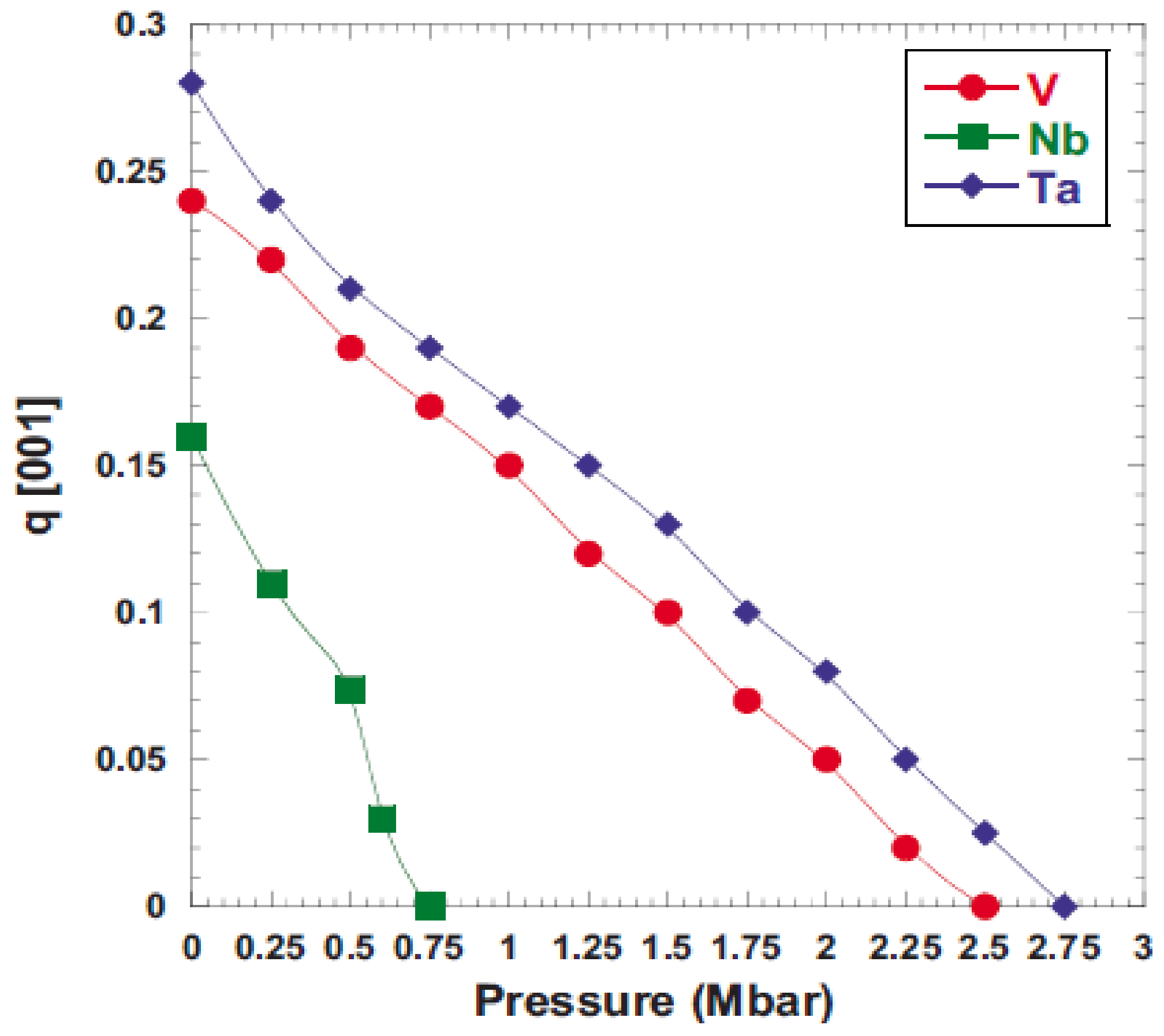
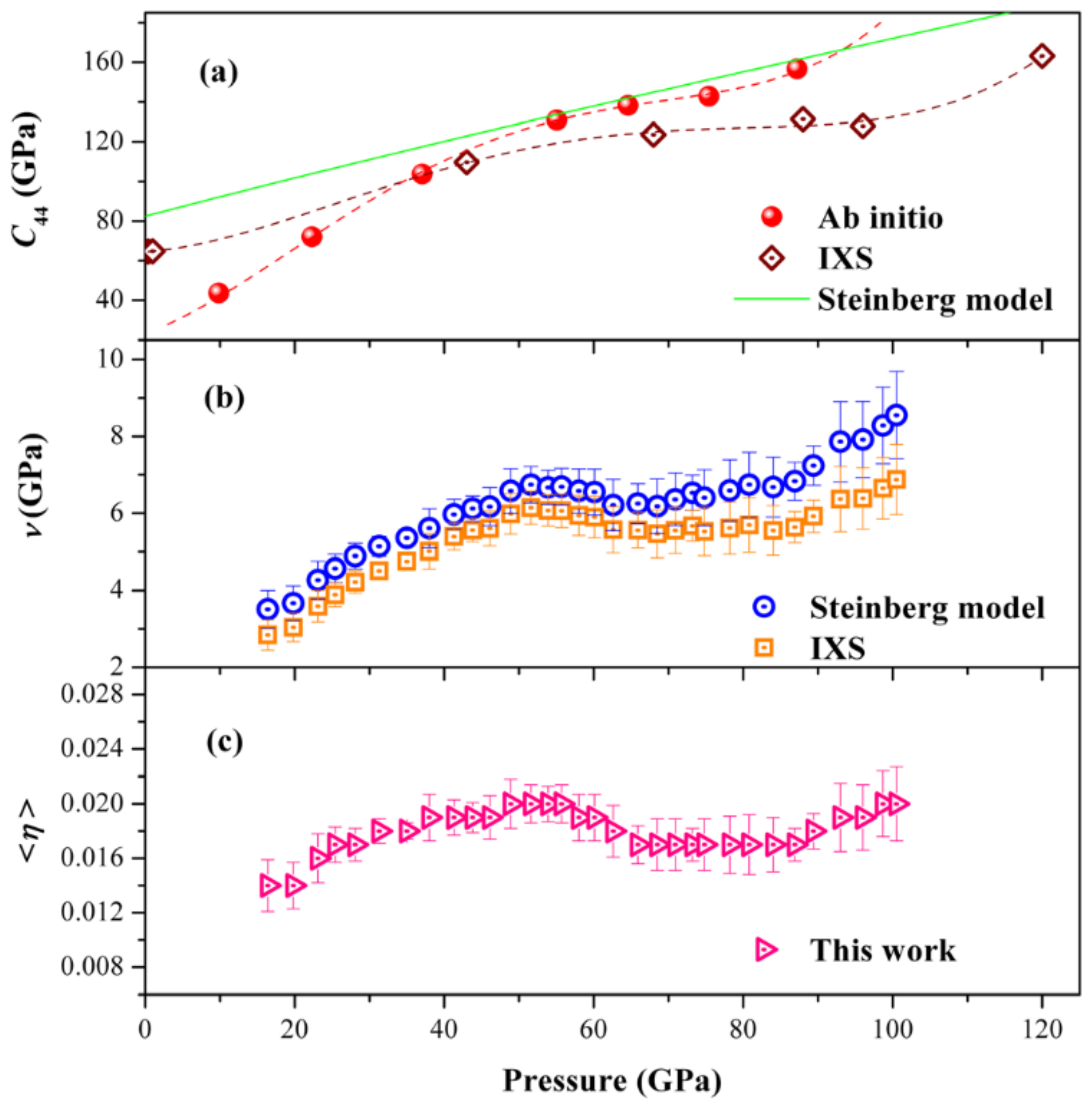
© 2018 by the authors. Licensee MDPI, Basel, Switzerland. This article is an open access article distributed under the terms and conditions of the Creative Commons Attribution (CC BY) license (http://creativecommons.org/licenses/by/4.0/).
Share and Cite
Landa, A.; Söderlind, P.; Naumov, I.I.; Klepeis, J.E.; Vitos, L. Kohn Anomaly and Phase Stability in Group VB Transition Metals. Computation 2018, 6, 29. https://doi.org/10.3390/computation6020029
Landa A, Söderlind P, Naumov II, Klepeis JE, Vitos L. Kohn Anomaly and Phase Stability in Group VB Transition Metals. Computation. 2018; 6(2):29. https://doi.org/10.3390/computation6020029
Chicago/Turabian StyleLanda, Alexander, Per Söderlind, Ivan I. Naumov, John E. Klepeis, and Levente Vitos. 2018. "Kohn Anomaly and Phase Stability in Group VB Transition Metals" Computation 6, no. 2: 29. https://doi.org/10.3390/computation6020029





